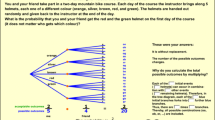Summary
The purpose of this experiment was to measure the relative effectiveness of eight types of visual illustrations used to complement oral instruction and to investigate the hypothesis that color is an important instructional variable for facilitating student achievement of specific educational objectives. Nine complete slide sequences possessing differing degrees of realistic detail were produced so that variations in visual stimuli could be assessed in terms of their ability to facilitate student achievement on five criterial measures. Two hundred sixty-one college students were randomly assigned to one of the nine treatment groups. Each student received a pretest, participated in one of the instructional presentations, and received four individual criterial measures. The results of this study suggest a number of conclusions to be taken into consideration in the preparation of visualized instruction at the college level:
-
1.
For specific learning objectives the addition of color in certain types of visuals appears to be an important instructional variable in improving student achievement.
-
2.
The use of visuals (both black-and-white and color) to complement oral instruction does not automatically improve student achievement of all types of learning objectives.
-
3.
Different types of colored illustrations differ in the effectiveness with which they facilitate student achievement of identical educational objectives.
-
4.
Different types of black-and-white illustrations differ in the effectiveness with which they facilitate student achievement of identical educational objectives.
Similar content being viewed by others
References
Attneave, F.Application of information theory to psychology. New York: Henry Holt, 1959.
Barlow, H. B. Possible principles underlying the transportation of sensory messages. In W. A. Rosenblith (Ed.),Sensory communication. New York: Wiley, 1961. Pp. 217–234.
Birren, F. The effects of color on the human organism.American journal of Occupational Therapy, 1959,13, 125–129.
Bourne, L. E., & Restle, F. Mathematical theory of concept identification.Psychological Review, 1959,66, 278–296.
Broadbent, D. E. Information processing in the nervous system.Science, 1965,150, 457–462.
Burke Marketing Research, Inc.Burke color study. Cleveland: AVCO Broadcasting Corporation, 1960.
Carpenter, C. R. A theoretical orientation for instructional film research.AV Communication Review, 1953,1, 38–52.
Cherry, C. E. Some experiments on the recognition of speech with one and two ears.Acoustical Society of America Journal, 1953,25, 975–979.
Dale, E.Audio-visual methods in teaching, New York: Dryden Press, 1946.
Dwyer, F. M. A study of the relative effectiveness of varied visual illustrations. Final Report. U.S. Department of Health, Education and Welfare, Project No. 6-8840. University Division of Instructional Services, The Pennsylvania State University, 1967.
Dwyer, F. M. Effect of visual stimuli on varied learning objectives.Perceptual and Motor Skills, 1968,27, 1067–1070. (a)
Dwyer, F. M. Effect of varying amount of realistic detail in visual illustrations designed to complement programmed instruction.Perceptual and Motor Skills, 1968,27, 351–354. (b)
Dwyer, F. M. The effect of stimulus variability on immediate and delayed retention.Journal of Experimental Education, 1969,38, 30–37. (a)
Dwyer, F. M. An experiment in visual communication.Journal of Research in Science Teaching, 1969,37, 67–75. (b)
Dwyer, F. M. Exploratory studies in the effectiveness of visual illustrations.AV Communication Review, 1970,18, 235–249.
Feigenbaum, E. A., & Simon, H. A. Brief notes on the EPAM theory of verbal learning. In C. N. Cofer & Barbara S. Musgrave (Eds.),Verbal behavior and learning. New York: McGraw-Hill Book Co., 1963. Pp. 333–335.
Gallup and Robinson, Inc.Are color TV commercials worth the extra cost? New York Association of National Advertisers, Inc., 1965.
Gerard, R. Color and emotional arousal.American Psychologist, 1958,13, 340. (Abstract)
Gibson, J. J. A theory of pictorial perception.AV Communication Review, 1954,2, 3–23.
Goldstein, K. Some experimental observations concerning the influence of color on the function of the organism.Occupational Therapy, 1942,21, 147–151.
Green, B. F., & Anderson, L. K. Color coding in a visual search task.Journal of Experimental Psychology, 1956,51, 19–24.
Ibison, R. A. Differential effects in the recall of textual materials associated with the inclusion of colored and uncolored illustrations. Unpublished doctoral dissertation, Indiana University, Bloomington, 1952.
Jacobson, H. The informational capacity of the human eye.Science, 1951,113, 292–293.
Kanner, J. H., & Rosenstein, A. J. Television in army training: Color vs black and white.AV Communication Review, 1960,8, 243–252.
Kanner, J. H., & Rosenstein, A. J. Television and army training: Color vs black and white.AV Communication Review, 1961,9, 44–49.
Kouwer, B.Colors and their character. Martinus Nijoff, 1949.
Lumsdaine, A. A. Instruments and media of instruction. In N. L. Gage (Ed.),Handbook of research on teaching. Chicago: Rand-McNally, 1963. Pp. 583–682.
MacLean, W. P. A comparison of colored and uncolored pictures.Educational Screen, 1930,9, 196–199.
May, M. A., & Lumsdaine, A. A.Learning from films. New Haven: Yale University Press, 1958.
Miller, N. E. (Ed.) Graphic communication and the crisis in education.AV Communication Review, 1957,5, 1–120.
Morris, C. W.Signs, language and behavior. New York: Prentice-Hall, 1946.
Otto, W., & Askov, E. The role of color in learning and instruction.Journal of Special Education, 1968,2, 155–165.
Peterson, L. R., & Peterson, M. J. The role of context stimuli in verbal learning.Journal of Experimental Psychology, 1957,53, 102–105.
Rappaport, M. The role of redundancy in the discrimination of visual forms.Journal of Experimental Psychology, 1957,53, 3–10.
Rudisill, M. Children’s preferences for color versus other qualities in illustrations.Elementary School Journal, 1952,52, 444–451.
Saltz, E. Compound stimuli in verbal learning: Cognitive and sensory differentiation versus stimulus selection.Journal of Experimental Psychology, 1963,66, 1–5.
Sparks, J. N. Expository notes on the problem of making multiple comparisons in a completely randomized design.Journal of Experimental Education, 1963,4, 344–349.
Travers, R. M. W. The transmission of information to human receivers.AV Communication Review, 1964,12, 373–385.
VanderMeer, A. W. Relative effectiveness of color and black and white in instructional films. Technical Report, SDC-269-7-28, Special Devices Center, Office of Naval Research, Port Washington, New York, 1952.
Weiss, W., & Margolius, G. The effect of context stimuli on learning and retention.Journal of Experimental Psychology, 1954,48, 318–322.
Winer, B. J.Statistical principles in experimental design. New York: McGraw-Hill, 1962.
Zuckerman, J. V. Predicting film learning by prerelease testing.AV Communication Review, 1954,2, 49–56.
Author information
Authors and Affiliations
Rights and permissions
About this article
Cite this article
Dwyer, F.M. Color as an instructional variable. ECTJ 19, 399–416 (1971). https://doi.org/10.1007/BF02768365
Issue Date:
DOI: https://doi.org/10.1007/BF02768365




